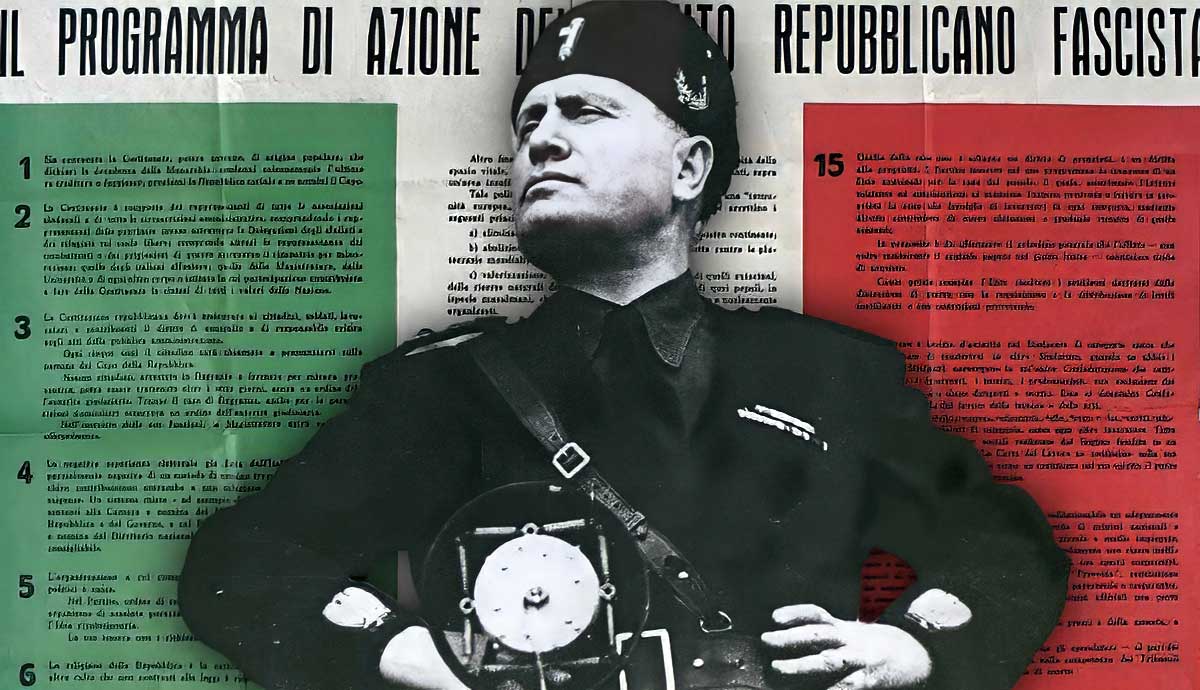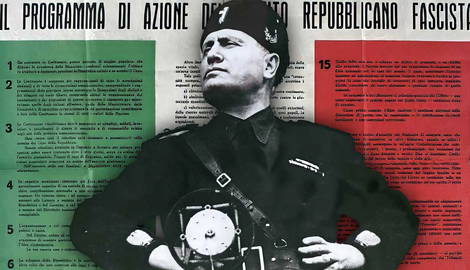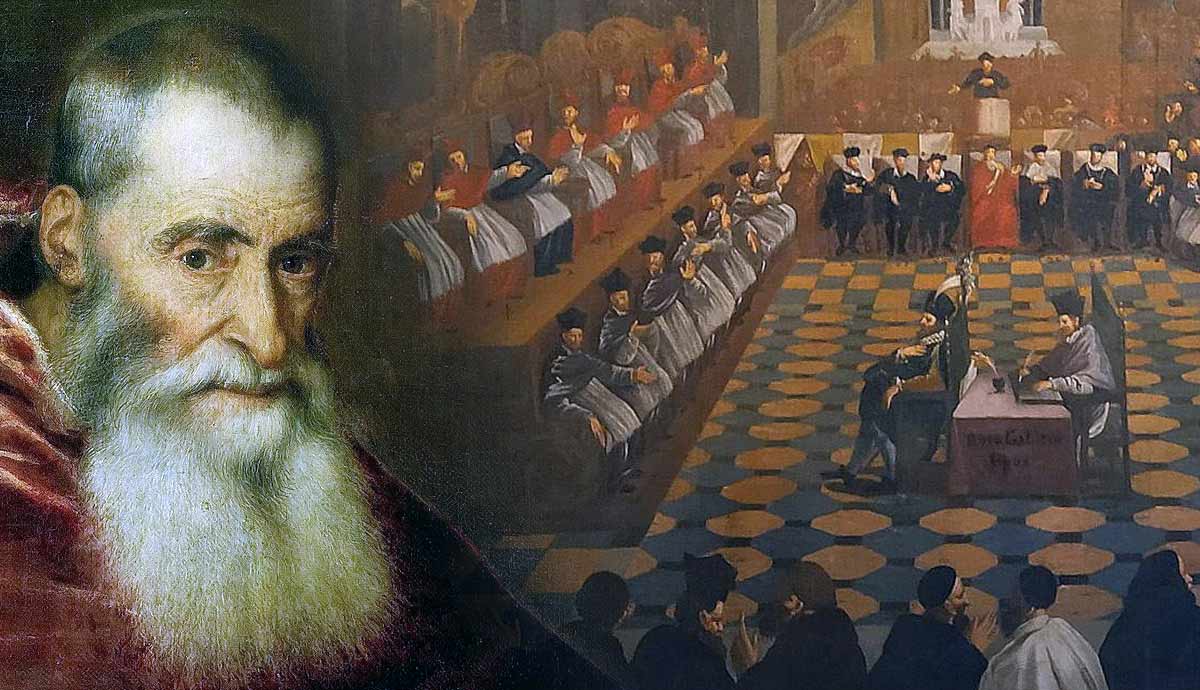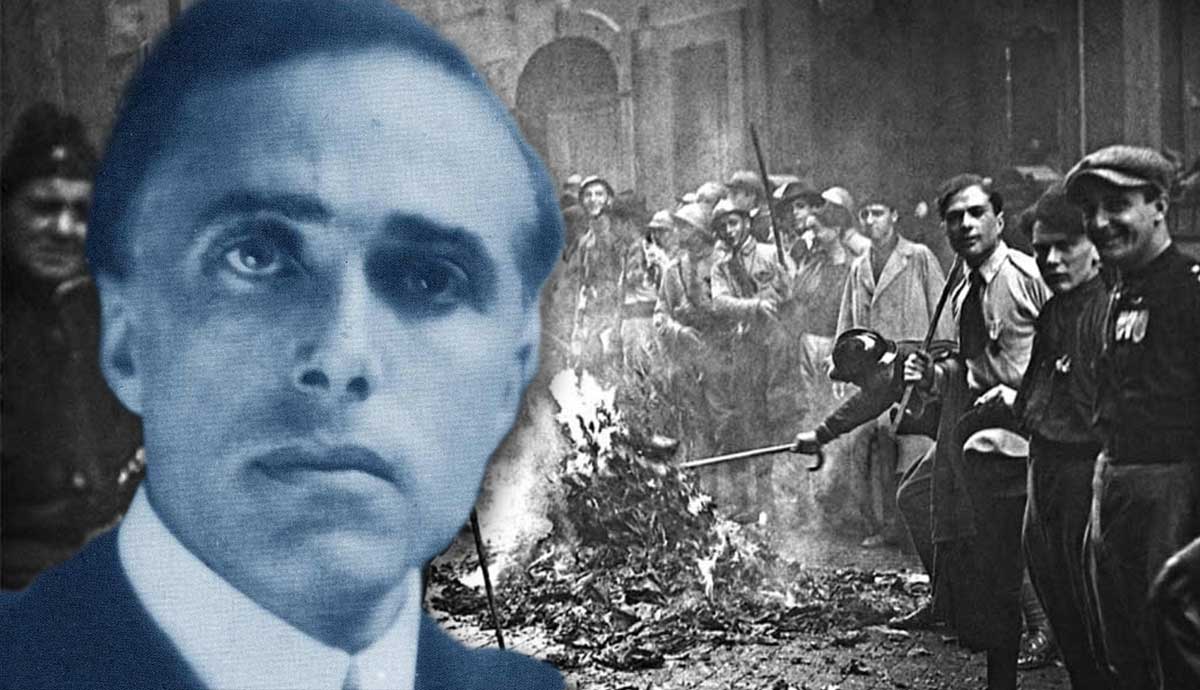
In the summer of 1943, the Fascist regime was on the brink of collapse. Shortly after the Allied invasion of Sicily, Mussolini was ousted from power and arrested. However, after two months in prison, a group of German soldiers helped him escape. On Hitler’s suggestion, the Duce established a new fascist government, the Italian Social Republic (RSI), in the north of the peninsula. The satellite state continued to fight alongside Nazi Germany and collaborated with the German troops in their operations against the partisans and Jews.
From the Fall of Mussolini to the Establishment of the Italian Social Republic

By the summer of 1943, the Fascist regime was in deep crisis. After the disastrous military campaigns in Greece, the Balkans, North Africa, and Russia, the morale among Italian soldiers was at an all-time low. The civilian population throughout the peninsula faced frequent food shortages. In the north, the heavy Allied bombing damaged countless factories and halted production. Many Italians no longer believed the regime’s exaggerated propaganda.
After the Allied invasion of Sicily, the military, political, and industrial circles started to plan Mussolini’s removal from power to avoid a complete catastrophe. On July 24, 1943, Dino Grandi, the former president of the Chamber of Fasces and Corporations, organized a meeting of the Fascist Grand Council to discuss the situation. On the night between July 24 and 25, Grandi called a motion of no confidence to remove Mussolini from power. In the end, the vast majority of the council (19 members) voted in favor of the motion. On July 25, King Victor Emmanuel III summoned Mussolini to the Quirinale Palace to dismiss him. After the meeting, the Duce was arrested by the police. Soon after, the king appointed Marshal Pietro Badoglio, the former commander of the Italian troops in Ethiopia, as prime minister. A wave of spontaneous demonstrations followed the news of Mussolini’s downfall, with many Italians toppling statues of the dictator and throwing out fascist symbols and uniforms.

On September 8, the Badoglio government announced the signing of the armistice of Cassibile between Italy and the Allies, thus ending its alliance with the Axis forces. The lack of clear orders immediately plunged the Italian troops into chaos. Many soldiers deserted, others joined the anti-fascist Resistenza, and countless were taken prisoners by their former allies. Meanwhile, the German army began the occupation of the peninsula. The king and the government fled Rome to take refuge in the Allied-controlled south. On September 12, a group of German commandos helped Mussolini escape from Hotel Campo Imperatore on the Gran Sasso, a mountain group in Abruzzo. The Duce was then transported to Germany, where, after some initial hesitation, he agreed to establish a new fascist state in northern Italy.

On September 18, in his first radio broadcast after his rescue, Mussolini announced the restoration of the Fascist regime in the country. After accusing the Savoy monarchy of betrayal, he said that the new state “will be national and social in the fullest sense of the words. It will thus be Fascist in a way that takes us back to our origins.” He further declared that the Italian Social Republic would continue to fight alongside the Germans. The Republican Fascist Party would replace the National Fascist Party disbanded after the fall of the regime. Some days later, King Victor Emmanuel III officially repudiated the new fascist republic, restating that the Badoglio government was the only legitimate political entity in the peninsula.

Though Mussolini claimed authority on the entire peninsula, the actual territory of the Italian Social Republic was limited to the northern and central areas occupied by the German troops. As the government was based in Salò, a town near Lake Garda, the new regime became commonly known as the Republic of Salò. Since the beginning, the Republic of Salò was a satellite state controlled by the Germans. For this reason, several Italian and international historians have dubbed it a “puppet state.” Only the Axis powers accorded the RSI diplomatic recognition.
The Trial Against the “Traitors”

One of the first goals of the newly established Republic of Salò was to exact revenge on the high-ranking fascist officials who had voted in favor of the motion of no confidence in Mussolini. In October 1943, the new government’s cabinet established a Tribunale speciale (ad-hoc court of justice) to try for treason the fascists who “betrayed” the regime, those who “defamed” Fascism after July 25, and those who “committed acts of violence” against fascist symbols and officials. Over the following months, the police captured six of the 19 “treacherous” gerarchi, including former Foreign Minister Count Galeazzo Ciano, Mussolini’s son-in-law.
The trial took place in January 1944 in Verona. After three sessions, the jury presided by Aldo Vecchini sentenced five of the six defendants to death. Only Tullio Cianetti, the former Minister for Corporations, received a 30-year sentence. On July 26, 1943, Cianetti had written a letter to Mussolini stating that he regretted his vote in favor of the motion of no confidence. The other 13 “traitors,” including Dino Grandi, were condemned in absentia.
The Verona Manifesto & the Ideology of the Italian Social Republic

In his radio broadcast, Mussolini declared that the new state would return to the socialist and republican roots of the early fascist movement. The Duce’s intent materialized in the Verona Manifesto, an 18-point policy document redacted and approved during the Congress of Verona, the first and only official meeting of the new Republican Fascist Party. The congress took place between November 14 and 16, 1943. It is commonly regarded as the founding act of the Republic of Salò. However, the policies of the manifesto were never fully implemented.
The first point of the Verona Manifesto firmly called for the abolition of the monarchy and the appointment of a constituent assembly. “It is not the regime that has betrayed the monarchy,” Mussolini had bitterly remarked in his broadcast from Germany, “it is the monarchy that has betrayed the regime.” On this basis, the Republic of Salò claimed to be the only legitimate Italian state, representing the whole population. The assembly further declared that the new republic aimed to achieve two main geopolitical goals. Firstly, the reunification of the whole Italian peninsula. Secondly, the formal legitimation of Italy’s spazio vitale (living space, like the German Lebensraum). The members of the Republican Fascist Party also sought to establish a clean break with the previous economic policy. While the industrialists and business leaders backed the then staunchly anti-socialist National Fascist Party in 1922, they hastily withdrew their endorsement as the regime was about to collapse. As a result, in the Republic of Salò, Mussolini tried to implement left-wing economic measures, such as the nationalization of companies and lands, to simultaneously win the support of the working class and declare his intention to revive the ideology of the 1919 fascist movement.
The Persecution of Jewish People & the Fight against the Partisans

The seventh point of the Verona Manifest announced the fascist republic’s anti-Semitic policy: “Those belonging to the Jewish race are foreigners. During this war they belong to an enemy nationality.”
In 1938, the Racial Laws had already decreed the expulsion of all Jews from schools, universities, and professions. The Italian Social Republic’s manifesto deprived them of their citizenship. While the Badoglio government suspended the anti-Semitic laws, the new fascist state issued a series of orders to aid the German allies in their persecution of Jews. At the beginning of September 1943, the Nazi troops carried out the first deportation and massacre of Jewish people arrested in the occupied territories.
On November 30, 1943, the statement of the manifesto was followed up by the ordinanza n. 5 (decree number 5) signed by Minister of the Interior Guido Buffarini. The decree gave the order to arrest all Jewish people, send them to provincial concentration camps, and seize their properties. In the following months, using data from surveys carried out in 1938-39, the police started to round up thousands of Jews resident in the territory of the republic. Most of them were detained in the Fossoli concentration camp and the Risiera di San Sabba, a former rice mill near Trieste.
In 1944, San Sabba became the first and only Italian camp with a crematory oven. The Germans ran both Polizeihaftläger (police detention camps) and sent many Italian Jews to death camps in Poland and Germany. In January 1944, Tullio Tamburini ordered the liquidation of all Jewish communities. The same year, Mussolini created the Ispettorato generale della razza (General Inspectorate of Race) to centralize and intensify the anti-Semitic measures. Giovanni Preziosi, a staunch supporter of the Fascist regime’s racist policy, was appointed as Inspector General.

Besides collaborating with the Germans in the persecution of the Jews, the Italian Social Republic fought against the Resistance movement. Relying on information passed on by informants, they arrested and questioned countless partisan fighters. The soldiers of the National Republican Army also collaborated in many massacres carried out by the occupying German troops, such as the killings of Monte Sole (September 1944), a mountain area near Bologna, and Sant’Anna di Stazzema (August 1944), a small town in Tuscany.
In postwar Italy, historians commonly referred to these events as stragi nazifasciste (nazi-fascist massacres). The autonomous military group Decima MAS led by Junio Valerio Borghese, later known as Il principe nero (the Black Prince), was often employed in anti-partisan activities.
The Fall of the Italian Social Republic & Death of Mussolini

On December 16, 1944, Benito Mussolini held his last public speech at the Teatro Lirico in Milan. Facing an increasingly likely defeat, the Duce hinted at the possibility of negotiating with the Allied forces while reiterating his attacks against the king and the Badoglio government. It was the last time Mussolini made a public appearance.
In April 1945, as the US army and the partisans were liberating many Italian cities, Mussolini and his fascist government fled to Milan. From there, he tried to escape to Switzerland disguised as a German soldier with his long-time mistress Claretta Petacci. However, a group of partisans discovered and arrested him. On April 28, Mussolini and Petacci were shot at Dongo, a small town near Como. On the same day, his body, alongside those of other high-ranking fascist officials, was hung upside-down at Piazzale Loreto, a square in Milan where the Germans had shot 15 partisans and displayed their bodies in August 1944.










